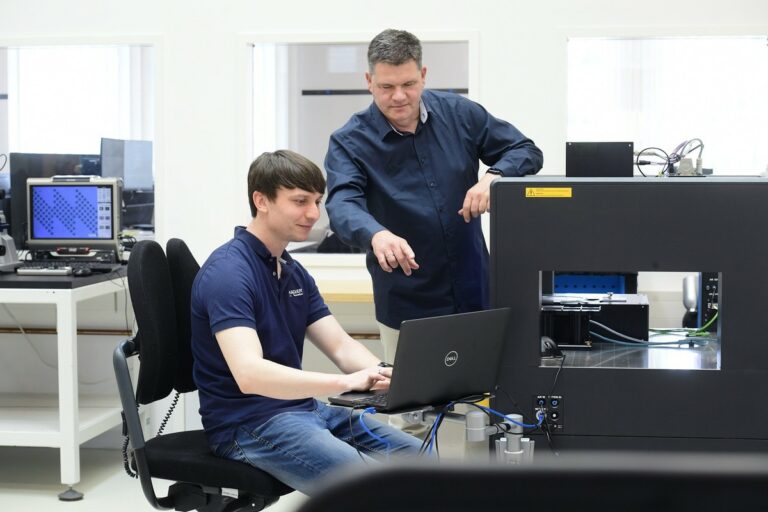Highly precise and efficient.
1. The ceramic substrate is measured at 3 positions with the 3D camera to determine the 3D position of the substrate (0-3 sec).
2. The Smarpod moves to a correction position to the position determined in step 1 (3-4 sec).
3. The substrate is measured a second time (4-7 sec).
4. The Smarpod makes another correction movement (8 sec).
5. The substrate is measured a third time and the result is found to be good (9-13 sec).
6. The Smarpod moves to the measuring position for the height measurement of the bond surface (13- 14 sec).
7. The linear axis with the measuring head of the confocal sensor moves into the measuring position – the exact height of the bond area is measured (15- 16 sec).
8. The linear axis with the measuring head of the confocal sensor moves back to the rest position (17 – 19 sec).
9. The smarpod moves back to the position it had reached in the 4th step (19 – 20 sec).
10. The placement head fetches an invisible component from the wafflepack holder (20 – 24 sec).
11. The placement head moves the component over the placement position (24 – 28 sec).
12. The smarpod moves the last millimeter towards the placement head to press on the invisible component in a defined way (29 sec).
13. The placement head puts down the invisible component and moves back to the overtravel height (30 -32 sec).
14. The smarpod moves back to its starting position (33 sec).
15. The process starts again from the beginning.
The processing of sensitive components is a particular challenge in process design. Secure release from the feeding system, the high risk of damage during pick-up or subsequent placement with a defined immersion depth in a dispensing medium are tasks that must be realized during the placing process.
Häcker Automation developed the PLACER TD, a touchdown placer for these complex process steps.
This placement head was designed for the precise alignment and placement of components. It is used, for example, when placement is to be carried out on pressure-sensitive substrates or when extremely precise measurement of the substrate height is required.
For this purpose, the placer has an inductive distance sensor in the Z direction, which detects when the component touches down on the surface of the substrate.
It is also possible to position the component in the Z-direction at a defined depth in a viscous or liquid medium.
Substrate feeding and supply is realized, for example, by means of a boat and a carrier on a vacuum support. Before the actual bonding process, the individual positions on the substrate that are inspected. These positions are used as references for the placement.
The appropriate dispensing material is then applied. In the process example shown, this is done by means of a pin transfer process on the Direct Dispensing Unit.
The wetted chip is then placed on the substrate. Afterwards, an automatic optical inspection of the products is realised.

Um dir ein optimales Erlebnis zu bieten, verwenden wir Technologien wie Cookies, um Geräteinformationen zu speichern und/oder darauf zuzugreifen. Wenn du diesen Technologien zustimmst, können wir Daten wie das Surfverhalten oder eindeutige IDs auf dieser Website verarbeiten. Wenn du deine Zustimmung nicht erteilst oder zurückziehst, können bestimmte Merkmale und Funktionen beeinträchtigt werden.